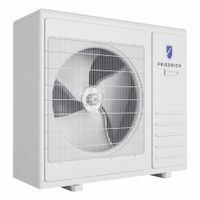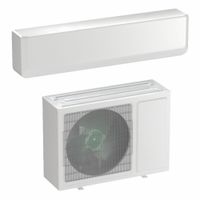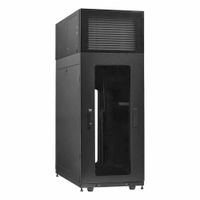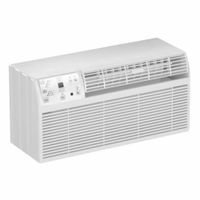Call +(254) 703 030 000 / 751 483 999 / 721 704 777
- Home
- Hvac And Refrigeration
- Air Conditioners Evaporative Coolers
- Air Conditioners
.....Read More
Frequently Asked Questions
How do air conditioners work?
Air conditioners work by removing heat and moisture from the air inside a space, thereby cooling it. The process involves several key components: a refrigerant, compressor, condenser, expansion valve, and evaporator.
1. **Refrigerant**: This is a fluid with a low boiling point that circulates through the air conditioning system, absorbing and releasing heat.
2. **Compressor**: The process begins with the compressor, which is located outside the building. It compresses the refrigerant, increasing its pressure and temperature, turning it into a hot, high-pressure gas.
3. **Condenser**: The hot gas then moves to the condenser coils, also located outside. Here, the refrigerant releases its heat to the outside air, facilitated by a fan that blows air over the coils. As the refrigerant loses heat, it condenses into a liquid.
4. **Expansion Valve**: The high-pressure liquid refrigerant then passes through an expansion valve or capillary tube, which reduces its pressure. This causes the refrigerant to cool rapidly and partially evaporate into a cold, low-pressure mixture.
5. **Evaporator**: The cold refrigerant then flows into the evaporator coils inside the building. A fan blows warm indoor air over these coils, and the refrigerant absorbs the heat from the air, causing it to evaporate into a gas. This process cools the air, which is then circulated back into the room.
6. **Cycle Repeats**: The refrigerant, now a warm gas, returns to the compressor, and the cycle repeats.
Additionally, air conditioners dehumidify the air as the evaporator coils condense moisture from the air, which is drained away. This entire cycle is controlled by a thermostat, which maintains the desired indoor temperature.
What is the difference between window and wall air conditioners?
Window air conditioners are designed to fit into a window or a specially designed opening in a wall. They are a single unit with all components enclosed, including the compressor, condenser, and evaporator. These units are typically more affordable and easier to install than wall air conditioners. They are ideal for cooling single rooms and are portable, allowing for easy removal and storage when not in use.
Wall air conditioners, on the other hand, are installed through a hole in an exterior wall. They are also a single unit but are generally more permanent installations compared to window units. Wall air conditioners often have a higher cooling capacity and are more energy-efficient, as they are better insulated and sealed. They do not obstruct windows, allowing for natural light and ventilation when the unit is not in use.
In summary, window air conditioners are more portable and easier to install, making them suitable for temporary or rental situations. Wall air conditioners offer more permanent, efficient cooling solutions for homeowners willing to invest in installation.
How do portable air conditioners compare to other types?
Portable air conditioners offer flexibility and ease of installation compared to other types. Unlike window units, they don't require permanent installation and can be moved from room to room, making them ideal for renters or those who need cooling in different areas at different times. They typically come with a hose that needs to be vented through a window or door, which can be less aesthetically pleasing than a window unit but offers more versatility.
In terms of cooling capacity, portable air conditioners are generally less efficient than window units and central air systems. They often have a lower BTU rating, meaning they may not cool large spaces as effectively. This can result in higher energy consumption and costs if used to cool large areas. However, for small to medium-sized rooms, they can be quite effective.
Central air conditioning systems provide whole-house cooling and are more energy-efficient for larger spaces, but they require professional installation and can be costly. Ductless mini-split systems offer a middle ground, providing efficient cooling without ductwork, but they also require installation and are more expensive than portable units.
Portable air conditioners can be noisier than other types, as the entire unit, including the compressor, is inside the room. This can be a drawback for those sensitive to noise. Additionally, they require regular maintenance, such as emptying the water collection tray or ensuring the hose is properly vented.
Overall, portable air conditioners are best suited for those who need a temporary, flexible cooling solution and are willing to trade off some efficiency and noise for convenience and mobility.
What are the benefits of ductless mini-split air conditioners?
Ductless mini-split air conditioners offer several benefits:
1. **Energy Efficiency**: They eliminate the energy losses associated with ductwork, which can account for up to 30% of energy consumption in traditional systems. This makes them more efficient and cost-effective.
2. **Zoned Cooling**: Mini-splits allow for individual temperature control in different rooms or zones, enhancing comfort and reducing energy waste by cooling only occupied spaces.
3. **Easy Installation**: Without the need for ductwork, installation is less invasive and quicker, making them ideal for retrofitting older homes or adding to new constructions.
4. **Flexibility**: They can be used in various settings, including homes, offices, and commercial spaces. Their compact size and design flexibility allow for installation in diverse locations.
5. **Improved Air Quality**: Many models come with advanced filtration systems that reduce dust, allergens, and other particulates, improving indoor air quality.
6. **Quiet Operation**: The indoor units are designed to operate quietly, making them suitable for bedrooms, offices, and other noise-sensitive areas.
7. **Heating Capability**: Many mini-splits offer both cooling and heating functions, providing year-round climate control.
8. **Aesthetic Appeal**: With sleek designs and various mounting options (wall, ceiling, floor), they blend well with interior decor.
9. **Remote Control and Smart Features**: Many systems come with remote controls and can be integrated with smart home systems for convenient operation.
10. **Reduced Carbon Footprint**: By using less energy and often employing eco-friendly refrigerants, they contribute to a lower environmental impact.
Overall, ductless mini-split systems provide a versatile, efficient, and user-friendly solution for modern climate control needs.
How does central air conditioning differ from other systems?
Central air conditioning differs from other systems primarily in its design, efficiency, and coverage. Unlike window units or portable air conditioners, central air conditioning systems are designed to cool entire buildings or large areas through a network of ducts. These systems consist of a central unit that cools air and distributes it via ductwork to various rooms, ensuring uniform temperature control throughout the space.
Central air systems are generally more efficient for cooling large areas compared to individual units, as they can maintain a consistent temperature and humidity level across multiple rooms. This efficiency is partly due to the use of a single, powerful compressor and evaporator coil, which can handle larger volumes of air than smaller, localized units.
In terms of installation, central air conditioning requires a more complex setup, involving ductwork and vents throughout the building. This can be more costly and time-consuming compared to installing a window or portable unit, which are typically plug-and-play solutions. However, once installed, central systems often provide better energy efficiency and lower operating costs over time.
Central air conditioning also offers better air quality control. These systems often include advanced filtration options that can remove dust, pollen, and other allergens from the air, improving indoor air quality. Additionally, central systems can be integrated with smart thermostats and zoning systems, allowing for precise control over different areas of a building.
In contrast, other systems like window units, portable air conditioners, and split systems are more suitable for cooling individual rooms or smaller spaces. They are generally less expensive to purchase and install but may not offer the same level of efficiency, coverage, or air quality control as central air conditioning systems.
What size air conditioner do I need for my space?
To determine the appropriate size air conditioner for your space, you need to calculate the required cooling capacity in British Thermal Units (BTUs). Follow these steps:
1. **Measure the Area**: Calculate the square footage of the space by multiplying the length by the width.
2. **BTU Calculation**: Use the general guideline of 20 BTUs per square foot. For example, a 500 square foot room would need approximately 10,000 BTUs (500 x 20).
3. **Consider Ceiling Height**: If the ceiling is higher than 8 feet, increase the BTU capacity by 10% for each additional foot.
4. **Account for Sunlight**: If the room receives a lot of sunlight, increase the BTU by 10%. Conversely, if it is heavily shaded, reduce the BTU by 10%.
5. **Occupancy**: Add 600 BTUs for each additional person regularly occupying the space beyond two people.
6. **Appliances and Equipment**: If the room contains heat-generating appliances, add extra BTUs. For example, add 4,000 BTUs for a kitchen.
7. **Climate Considerations**: In hotter climates, you may need a unit with a higher BTU rating.
8. **Insulation and Windows**: Poor insulation or numerous windows may require a higher BTU rating to maintain comfort.
9. **Consult a Professional**: For complex spaces or to ensure accuracy, consult with an HVAC professional.
By considering these factors, you can select an air conditioner that efficiently cools your space without wasting energy.
How can I improve the efficiency of my air conditioner?
1. **Regular Maintenance**: Schedule annual professional maintenance to ensure the system is running efficiently. Clean or replace filters every 1-2 months to maintain airflow and reduce strain on the system.
2. **Thermostat Management**: Use a programmable or smart thermostat to optimize cooling schedules. Set the temperature higher when you’re away and lower it when you’re home to save energy.
3. **Seal and Insulate**: Ensure your home is well-insulated and seal any leaks around windows, doors, and ductwork to prevent cool air from escaping and warm air from entering.
4. **Shade and Ventilation**: Use blinds, curtains, or shades to block direct sunlight. Plant trees or install awnings to provide shade. Use ceiling fans to circulate air and reduce the load on the AC.
5. **Upgrade Equipment**: Consider upgrading to a more energy-efficient model if your unit is over 10-15 years old. Look for units with a high SEER (Seasonal Energy Efficiency Ratio) rating.
6. **Optimize Airflow**: Keep vents and registers clear of obstructions like furniture or curtains. Ensure that the outdoor unit is free from debris and has adequate clearance for proper airflow.
7. **Reduce Heat Sources**: Minimize the use of heat-generating appliances during the hottest parts of the day. Use energy-efficient lighting and appliances to reduce heat output.
8. **Zoning Systems**: Implement zoning systems to cool only the areas in use, reducing the workload on the AC.
9. **Humidity Control**: Use a dehumidifier to reduce humidity levels, making the air feel cooler and allowing you to set the thermostat higher.
10. **Energy Audits**: Conduct an energy audit to identify areas for improvement and implement recommended changes to enhance efficiency.





